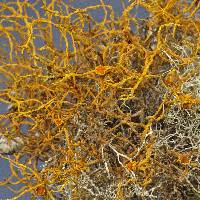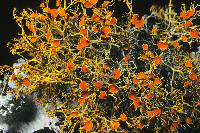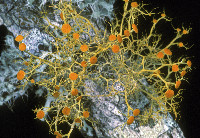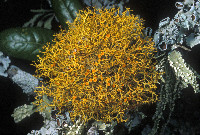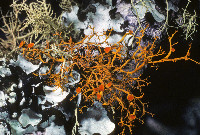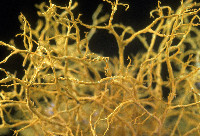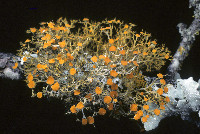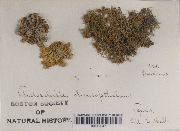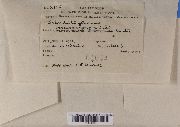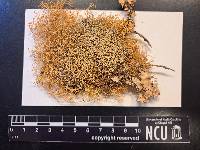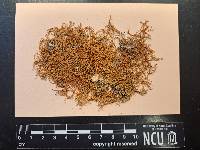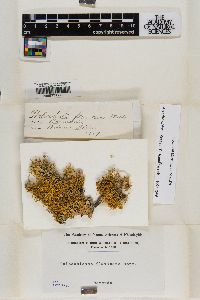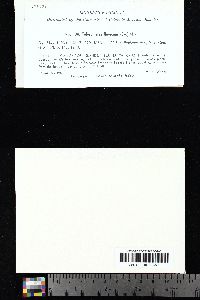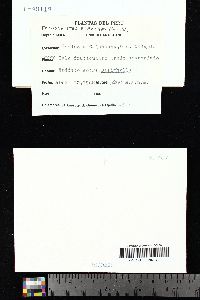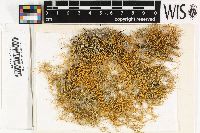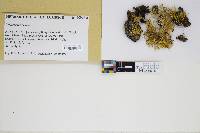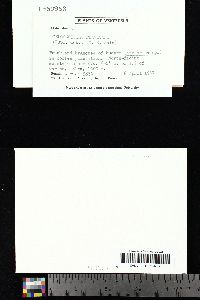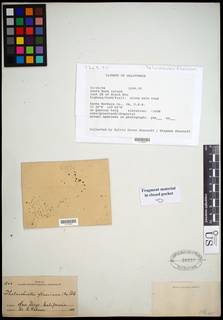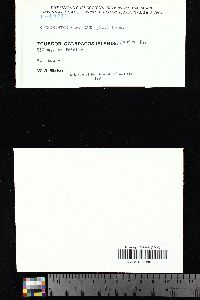
- Home
- Search
- Images
- Species Checklists
- US States: O-Z >
- US National Parks
- Central America
- South America
- US National Parks
- Southern Subpolar Region
|
|
|
|
Family: Teloschistaceae
[Alectoria epichrysa Stirt., moreAnaptychia flavicans (Sw.) A. Massal., Borrera acromela Pers., Borrera flavicans (Sw.) Ach., Borrera flavicans f. flavicans (Sw.) Ach., Borrera flavicans f. laeta Ach., Cornicularia crocea Ach., Cornicularia flavicans Pers., Evernia flavicans (Sw.) Fr., Evernia flavicans f. maxima Meyen & Flot. nom. inval., Evernia flavicans var. melanotricha Meyen & Flot., Lichen flavicans Sw., Lobaria flavicans (Sw.) Trevis., Parmelia chrysophthalma var. flavicans (Sw.) Eschw., Parmelia flavicans (Sw.) Ach., Physcia acromela (Pers.) Nyl., Physcia chrysophthalma var. flavicans (Sw.) Tuck., Physcia flavicans (Sw.) DC., Teloschistes acromelus (Pers.) Vain., Teloschistes capensis var. cinerascens (Stein) C.W. Dodge, Teloschistes chrysophthalmus var. flavicans (Sw.) Tuck., Teloschistes flavicans f. cinerascens (Stein) Müll. Arg., Teloschistes flavicans f. flavicans (Sw.) Norman, Teloschistes flavicans f. hirtella Vain., Teloschistes flavicans f. hirtellus Vain., Teloschistes flavicans f. laetus (Ach.) Müll. Arg., Teloschistes flavicans f. uruguayensis Gyeln., Teloschistes flavicans var. acromelus (Pers.) Müll.Arg., Teloschistes flavicans var. compressus Js. Murray, Teloschistes flavicans var. croceus (Ach.) Müll.Arg., Teloschistes flavicans var. flavicans (Sw.) Norman, Teloschistes flavicans var. intermedius Müll. Arg., Teloschistes flavicans var. laetus (Ach.) Hillmann, Teloschistes flavicans var. maximus (Meyen & Flot.) Zahlbr., Teloschistes flavicans var. melanotrichus (Meyen & Flot.) Müll. Arg., Teloschistes flavicans var. roccelliformis Räsänen, Teloschistes flavicans var. tenuissima (Meyen & Flot.) Müll. Arg., Tornabenia flavicans (Sw.) A. Massal., Tornabenia flavicans f. cinerascens Stein, Tornabenia flavicans f. flavicans (Sw.) A. Massal., Xanthoria flavicans (Sw.) H. Olivier] |
MB#355609 Basionym: Lichen flavicans Sw., Prodr.: 147. 1788; MB#462958. Description. Thallus fruticose, overall color typically deep yellow to almost reddish orange, in small erect tufts or relatively large clusters of loosely entangled branches, overall 1.5–5(–10) cm in diam.; branches ± flexible, up to 1.5 mm wide, irregularly terete, not distinctly flattened, not dorsiventral, typically at least apically ciliate, occasionally also with sparse cilia along the side; cilia often blackened at their tip; cortex dull, with sparse to abundant cortical hairs, rarely ± tomentose, surface irregularly wrinkled, but not cracked (apart from the areas where soralia are formed); overall branching pattern ± dichotomous, apices straight to irregularly curved; soralia common, typically abundant, initially punctiform, then orbicular, but soon broadened to elongate, typically developing along the side of the branches and occasionally confluent, with pale to deep yellow, farinose to ± granular soredia, which are rarely budding into short cilia or even secondary branches, but more typically erode, leaving ± labriform scars. Apothecia very rare (found in one Galapagos specimen only), developing along the side of the branches, sessile to barely stalked, (0.6–)1–3(–4) mm in diam., ± undulate; lecanorine; thalline margin entire to ± undulate, regularly circular, densely sorediate, occasionally with sparse, short cilia; disc deeply orange, epruinose; epihymenium with brownish to orange pigment granules, C–, K+ purple, contiguous with the outer exciple; hymenium hyaline, not inspersed; proper exciple indistinct (almost completely reduced); thalline exciple differentiated into a hyaline inner part, a central part abundantly filled with photobionts, lacking crystals, and an outer part with brownish to orange pigment granules, C–, K+ purple; subhymenium and hypothecium poorly differentiated, hyaline, not inspersed; asci clavate, Teloschistes-type; ascospores 8/ascus, polaribilocular, oblong to narrowly ellipsoid, (9.5–)11.3–17.8(–20.3) × (5.0–)6.0–8.5(–9.5) μm, with a distinctly broadened, (3.3–)3.5–8.6(–11.0) μm wide septum (n = 39). Pycnidia not observed. Chemistry. Thallus and apothecia P–, K+ purple, C–, KC± purplish (fading), UV– (dull); contains high proportions of parietin and caloploicin, lesser proportions of teloschistin, fallacinal, parietinic acid, vicanicin and isofulgidin, occasionally also with emodin (chemosyndrome A+2 sensu Søchting & Frödén 2002). This is the same syndrome as found in T. flavicans in South America (Søchting & Frödén 2002). Ecology and distribution. Widespread throughout the tropics and subtropics (Frödén et al. 2004) and in Galapagos extremely common. It is very characteristic of the lower, but still fog-drenched parts of the transition zone, among curtains of Ramalina usnea, R. anceps and Usnea mexicana, though best developed in habitats that are slightly drier, where the Ramalina and Usnea species are not dominant. Small thalli are typically found also in the dry zone further below and rarely even directly at the coast. The species is generally less abundant but still regularly present also in the humid zone. It typically grows on bark, but occasionally it can be found on cacti or even stems of herbaceous plants, and rarely also on rock. Notes. Diagnostic differences of T. chrysophtalmus are discussed there. Nash, T.H., Ryan, B.D., Gries, C., Bungartz, F., (eds.) 2004. Lichen Flora of the Greater Sonoran Desert Region. Vol 2. Thallus: fruticose to somewhat subfruticose, 1.5-7(-10) cm long, 2-4 cm in diam., tufted or rarely pulvinate to erect and loosely attached, +dichotomously lobate lobes: corticated on both sides (no distinct underside), with rigid, entangled main branches 0.2-1.5 mm wide (fertile specimens usually broader than sorediate ones), narrowing down to 0.05-0.2 mm at the tips, terete to somewhat flattened and broadened at the angles, with terete (especially towards the tips) secondary branches surface: pale yellow to reddish orange or more rarely pale gray, smooth, with soralia or soralia initials, sometimes partly tomentose, sometimes striate to verrucose, corticated on both sides (not dorsiventral) and no cracks (though soralia can be fissural); cilia: on all parts of the lobes but most common near the lobe ends (also on side lobes), sometimes branched or curved, sometimes with red to blackish red tips, 0.1-0.7 mm long hairs: straight, short and mostly unbranched, consisting of single rows of cells, separate or loosely conglutinated soredia: basically farinose but sometimes becoming granular or even beginning to grow and form lateral branches, in orbicular to elongated soralia on all sides of the thallus, that initially are spots on the surface and gradually erode away the thallus sometimes making lip shaped soralia, that are mostly discrete but sometimes become confluent, usually not well developed in fertile specimens lobe anatomy: composed of two irregular layers cortex: prosoplectenchymatous, composed of +longitudinally running hyphae, 10-60 µm thick or running all the way through; cortical hyphae: 1.5-3 µm thick with c. 0.5 µm thick walls, somewhat lax and separating (pretreated in K followed by water) medulla: interrupted by cortical strands with algae in scattered groups, 50-125 µm thick Apothecia: absent to frequent, laminal or marginal, sessile to stipitate, 0.8-4 mm in diam. disc: orange to brownish red, often much darker than the thallus and contrasting against the margin, concave when young, but soon becoming plane to convex; thalline margin: gray to yellow, usually with lighter spots or a lighter rim (lighter than the thallus), entire to crenulate when young, usually crenulate to crenate when mature, often becoming excluded with age, without cilia asci: oblong to clavate, 52-75 x 14-20 µm, 8-spored ascospores: hyaline, polaribilocular, oblong to narrowly ellipsoid, (10)12-18(-20) x 6-9 µm, septal width (3-)4-10(-11) Pycnidia: usually immersed to slightly protruding, in verrucose specimens larger, protruding to almost stipitate (reminding one of immature apothecia), 0.09-0.25 mm in diam. conidia: bifusiform, 2.7-3.7 x 1-1.5 µm Spot tests: K+ purple, C-, KC-, P- Secondary metabolites: anthraquinones: parietin (major), teloschistin, fallacinal, and parietinic acid (all minor), erythroglaucin (absent to minor) and emodin (trace); depsidones: caloploicin (major), vicanicin, and isofulgidin (both minor), and some unknown compounds (chemosyndrome A+2). Substrate and ecology: in very humid, warm habitats on conifers and other trees, bryophytes and rocks in coastal scrub near sea level World distribution: widespread in tropical to subtropical areas Sonoran distribution: rare on mainland of California, but very common on the Channel Islands and parts of Baja California. Notes: Morphologically and chemically Teloschistes flavicans is very variable, and numerous infraspecific taxa have been described. Specimens with black tipped cilia on the apothecia (sometimes called T. flavicans ssp. acromelus (Pers.) Vain.), are known from South America, Jamaica, and Africa. Fertile specimens are morphologically most similar to T. exilis (Mich.) Vain., that does not occur in the Sonoran region. Some specimens, especially from Texas, where both species occur, are very difficult to separate morphologically, but in T. flavicans the apothecia are usually darker reddish orange. Specimens with lighter orange colored apothecial discs are not uncommon, but they are never yellow. Teloschistes exilis has yellow to orange apothecia discs and the lobes are often more strap shaped and also has no soralia, soralia initials, or colored cilia tips. There are chemical differences as well, as T. flavicans contains depsidones in addition to the anthraquinones, which T. exilis never has. DNA data do not indicate that they are closely related either. Xanthoria pollinarioides L. Lindblom and D.M. Wright is similar to T. flavicans, but differs in cortex structure and in having ellipsoid conidia. Although T. flavicans sometimes grows with T. californicus and T. chrysophthalmus, it does not seems to be attacked by Spaerellothecium subtile that is so common on these species in the Sonora region. Teloschistes flavicans is, however, almost always parasitized by other fungi, which do not always show on the outside. |
|
|
|



